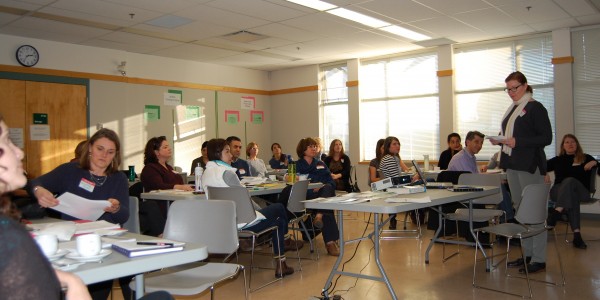Building healthy communities for better health outcomes
Did you know that if you spend more than 30 minutes commuting to work you are shortening your lifespan? That even includes folks who don’t smoke, eat only vegetables and get plenty of exercise.
This was one of the many facts highlighted at a special workshop on Healthy Built Environments between Vancouver Coastal Health and the District of North Vancouver (DNV) this week at Parkgate Community Centre.
“We have a lot of evidence that proves where you live has a significant impact on your health,” says Claire Gram, Policy Consultant & Healthy Built Environment Lead with VCH.
In fact, says Claire, about 60 per cent of population health outcomes are attributed to the places we live (the physical/built environment) and social and economic determinants.
Claire and a number of VCH staff members, including Medical Health Officer Dr. Mark Lysyshyn, joined forces with DNV planners for a pilot workshop to test the Healthy Built Environment (HBE) Linkages Toolkit. The B.C.-developed toolkit is the first evidence-based and expert informed resource that links planning principles to health outcomes.
“Health authorities are now working much more on chronic disease prevention and this means starting to work on HBE initiatives, food systems work, social connections and other determinants of health in collaboration with municipalities,” says Claire.
Healthy communities a key VCH Public Health priority
The healthy communities work is one of three priorities for VCH Public Health, which falls under the Ministry of Health’s “Healthy Families BC Communities” initiative. The number of municipal healthy living action plans is a performance measure for the health authority.
So what does a healthy built environment look like? Ideally, it should include:
- Compact communities with mixed land use, so that people can easily choose to walk, cycle, and take transit to various destinations
- A variety of housing choices in a neighbourhood for people with varied incomes and stages of the life
- Infrastructure like sidewalks and bike lanes that keep us safe and send the message that non-drivers are valuable and important!
- Access to healthy food options – local stores with healthy food, opportunities to grow food
- Clean air and water
- Places to gather for a vibrant and connected community
The DNV was the pilot site for the workshop during which participants learned about the HBE toolkit, how to use it, and how to build partnerships. While VCH has worked closely with the District on a number of health-related projects (e.g. Turning Point recovery houses for men and women), it officially began collaborating on planning issues with the DNV in 2011 when a Memorandum of Understanding was signed to ensure health evidence was included in all future community planning decisions.
“There is a good appetite to collaborate on HBE and quite a few ways we can do it. The linkages toolkit is a great start for these conversations that makes sense to the public and to the planners who participated,” says Claire.
VCH has agreements with nine municipalities
To date, VCH has signed agreements with nine municipalities (Richmond, Vancouver, City of North Vancouver, DNV, District of West Vancouver, Squamish, Gibsons, Sechelt and Powell River) and the Sunshine Coast Regional District. VCH is currently in discussion with Whistler, Pemberton, Bowen Island and Lions Bay.
“It’s these kinds of partnerships that will work and make things happen,” said DNV councillor Doug MacKay-Dunn to the 35 workshop participants. “It’s not trying to do more with less, but doing much much more with a little more.”

